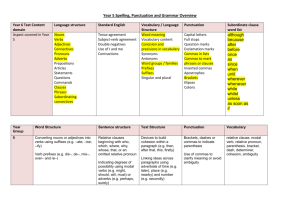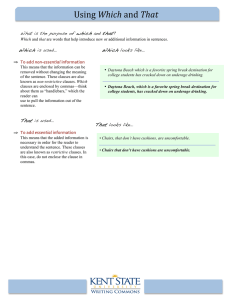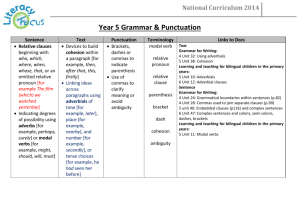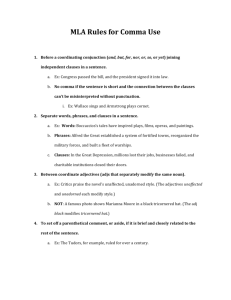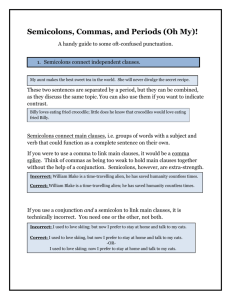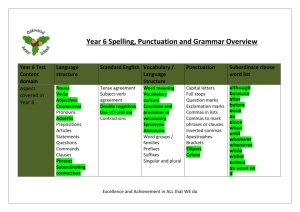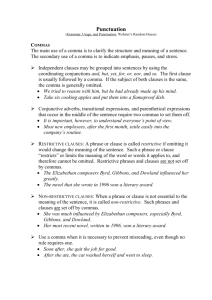Ms. Gerbig—Freshman English Grammar, Writing
advertisement
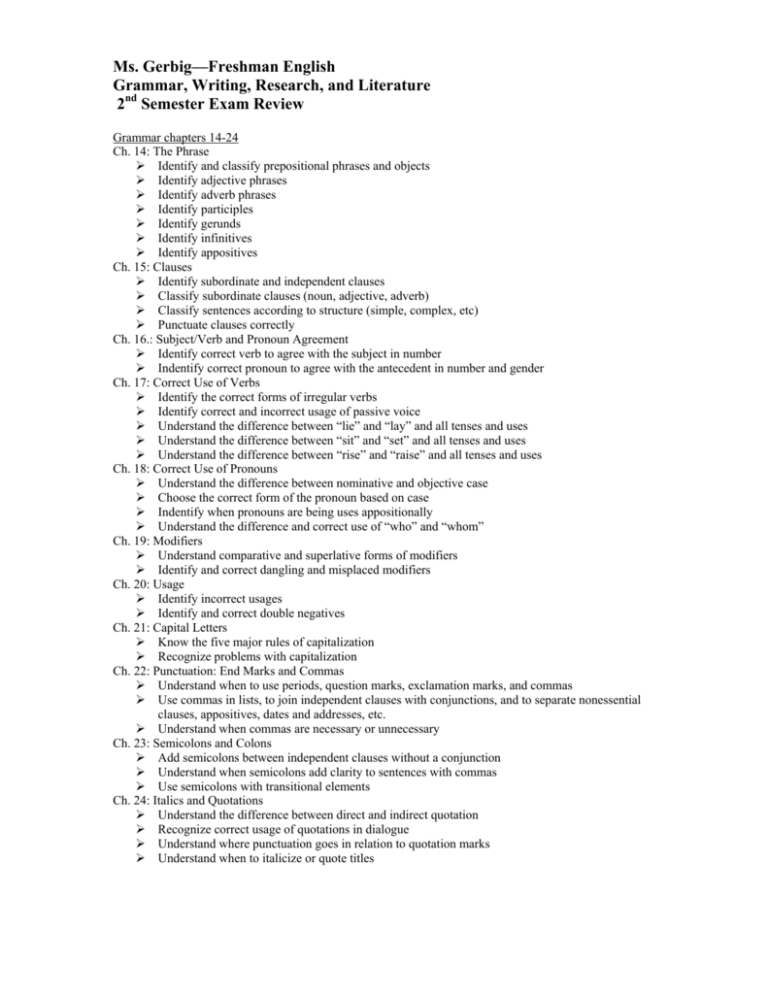
Ms. Gerbig—Freshman English Grammar, Writing, Research, and Literature 2nd Semester Exam Review Grammar chapters 14-24 Ch. 14: The Phrase Identify and classify prepositional phrases and objects Identify adjective phrases Identify adverb phrases Identify participles Identify gerunds Identify infinitives Identify appositives Ch. 15: Clauses Identify subordinate and independent clauses Classify subordinate clauses (noun, adjective, adverb) Classify sentences according to structure (simple, complex, etc) Punctuate clauses correctly Ch. 16.: Subject/Verb and Pronoun Agreement Identify correct verb to agree with the subject in number Indentify correct pronoun to agree with the antecedent in number and gender Ch. 17: Correct Use of Verbs Identify the correct forms of irregular verbs Identify correct and incorrect usage of passive voice Understand the difference between “lie” and “lay” and all tenses and uses Understand the difference between “sit” and “set” and all tenses and uses Understand the difference between “rise” and “raise” and all tenses and uses Ch. 18: Correct Use of Pronouns Understand the difference between nominative and objective case Choose the correct form of the pronoun based on case Indentify when pronouns are being uses appositionally Understand the difference and correct use of “who” and “whom” Ch. 19: Modifiers Understand comparative and superlative forms of modifiers Identify and correct dangling and misplaced modifiers Ch. 20: Usage Identify incorrect usages Identify and correct double negatives Ch. 21: Capital Letters Know the five major rules of capitalization Recognize problems with capitalization Ch. 22: Punctuation: End Marks and Commas Understand when to use periods, question marks, exclamation marks, and commas Use commas in lists, to join independent clauses with conjunctions, and to separate nonessential clauses, appositives, dates and addresses, etc. Understand when commas are necessary or unnecessary Ch. 23: Semicolons and Colons Add semicolons between independent clauses without a conjunction Understand when semicolons add clarity to sentences with commas Use semicolons with transitional elements Ch. 24: Italics and Quotations Understand the difference between direct and indirect quotation Recognize correct usage of quotations in dialogue Understand where punctuation goes in relation to quotation marks Understand when to italicize or quote titles Writing and Researching Understand the rules regarding, definitions for, and/or stylistic effects of the following: Transitions MLA Topic sentences Textual evidence Thesis Paraphrasing and direct quotation Quote integration Plagiarism Citation Literature Know the plots, themes, authors, style, point of view, characters, historical context, and literary qualities of the following: A Christmas Carol, by Charles Dickens Animal Farm “Georgia O’Keeffe” “I Have a Dream” “Celebration of Grandfathers” “Single Room, Earth View” “A Lincoln’s Preface” Know the definitions for the following figures of speech: Iamb Anecdote Personification Pentameter Folk ballad Metaphor Feet Epic Nonfiction Imagery Biography Simile Satire Irony Novel Blank verse Symbolism Alliteration Onomatopoeia Turning point Assonance Rhyme scheme Lyric Apostrophe Narrative Know these vocabulary words Archaic Agonize Antiseptic Digression Desolation Indifference Format, 200 points, Seven parts Part I: The Novella comprehension questions on literary elements: setting, major characters, plot, conflict Part II: Prose nonfiction General information on types, authors and titles Comprehension questions Part III: Poetry and poetic forms Analysis and interpretation Explication and scansion Titles and poets Part IV: Figures of speech Definitions and usage Part V: The research process Reference format (MLA) Paper format Quoting and plagiarism Part VI: Grammar Part VII: Two Essays (one section on Animal Farm; one section on A Christmas Carol/Nonfiction)


